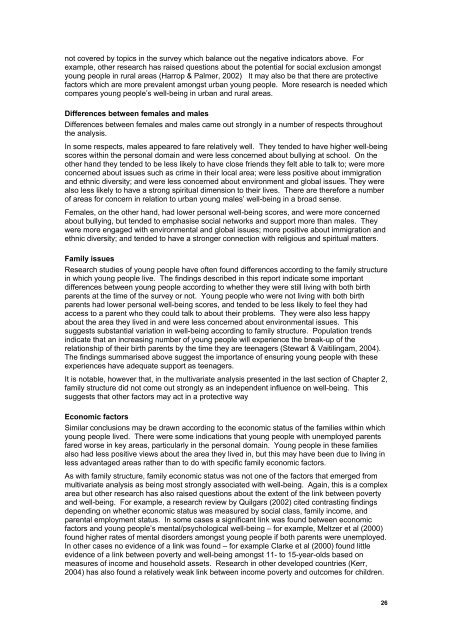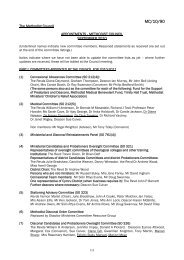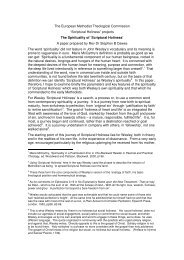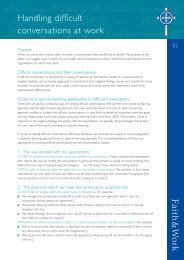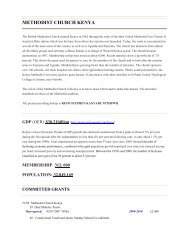Spiritual Health and the Well-Being of Urban Young People
Spiritual Health and the Well-Being of Urban Young People
Spiritual Health and the Well-Being of Urban Young People
Create successful ePaper yourself
Turn your PDF publications into a flip-book with our unique Google optimized e-Paper software.
not covered by topics in <strong>the</strong> survey which balance out <strong>the</strong> negative indicators above. Forexample, o<strong>the</strong>r research has raised questions about <strong>the</strong> potential for social exclusion amongstyoung people in rural areas (Harrop & Palmer, 2002) It may also be that <strong>the</strong>re are protectivefactors which are more prevalent amongst urban young people. More research is needed whichcompares young people’s well-being in urban <strong>and</strong> rural areas.Differences between females <strong>and</strong> malesDifferences between females <strong>and</strong> males came out strongly in a number <strong>of</strong> respects throughout<strong>the</strong> analysis.In some respects, males appeared to fare relatively well. They tended to have higher well-beingscores within <strong>the</strong> personal domain <strong>and</strong> were less concerned about bullying at school. On <strong>the</strong>o<strong>the</strong>r h<strong>and</strong> <strong>the</strong>y tended to be less likely to have close friends <strong>the</strong>y felt able to talk to; were moreconcerned about issues such as crime in <strong>the</strong>ir local area; were less positive about immigration<strong>and</strong> ethnic diversity; <strong>and</strong> were less concerned about environment <strong>and</strong> global issues. They werealso less likely to have a strong spiritual dimension to <strong>the</strong>ir lives. There are <strong>the</strong>refore a number<strong>of</strong> areas for concern in relation to urban young males’ well-being in a broad sense.Females, on <strong>the</strong> o<strong>the</strong>r h<strong>and</strong>, had lower personal well-being scores, <strong>and</strong> were more concernedabout bullying, but tended to emphasise social networks <strong>and</strong> support more than males. Theywere more engaged with environmental <strong>and</strong> global issues; more positive about immigration <strong>and</strong>ethnic diversity; <strong>and</strong> tended to have a stronger connection with religious <strong>and</strong> spiritual matters.Family issuesResearch studies <strong>of</strong> young people have <strong>of</strong>ten found differences according to <strong>the</strong> family structurein which young people live. The findings described in this report indicate some importantdifferences between young people according to whe<strong>the</strong>r <strong>the</strong>y were still living with both birthparents at <strong>the</strong> time <strong>of</strong> <strong>the</strong> survey or not. <strong>Young</strong> people who were not living with both birthparents had lower personal well-being scores, <strong>and</strong> tended to be less likely to feel <strong>the</strong>y hadaccess to a parent who <strong>the</strong>y could talk to about <strong>the</strong>ir problems. They were also less happyabout <strong>the</strong> area <strong>the</strong>y lived in <strong>and</strong> were less concerned about environmental issues. Thissuggests substantial variation in well-being according to family structure. Population trendsindicate that an increasing number <strong>of</strong> young people will experience <strong>the</strong> break-up <strong>of</strong> <strong>the</strong>relationship <strong>of</strong> <strong>the</strong>ir birth parents by <strong>the</strong> time <strong>the</strong>y are teenagers (Stewart & Vaitilingam, 2004).The findings summarised above suggest <strong>the</strong> importance <strong>of</strong> ensuring young people with <strong>the</strong>seexperiences have adequate support as teenagers.It is notable, however that, in <strong>the</strong> multivariate analysis presented in <strong>the</strong> last section <strong>of</strong> Chapter 2,family structure did not come out strongly as an independent influence on well-being. Thissuggests that o<strong>the</strong>r factors may act in a protective wayEconomic factorsSimilar conclusions may be drawn according to <strong>the</strong> economic status <strong>of</strong> <strong>the</strong> families within whichyoung people lived. There were some indications that young people with unemployed parentsfared worse in key areas, particularly in <strong>the</strong> personal domain. <strong>Young</strong> people in <strong>the</strong>se familiesalso had less positive views about <strong>the</strong> area <strong>the</strong>y lived in, but this may have been due to living inless advantaged areas ra<strong>the</strong>r than to do with specific family economic factors.As with family structure, family economic status was not one <strong>of</strong> <strong>the</strong> factors that emerged frommultivariate analysis as being most strongly associated with well-being. Again, this is a complexarea but o<strong>the</strong>r research has also raised questions about <strong>the</strong> extent <strong>of</strong> <strong>the</strong> link between poverty<strong>and</strong> well-being. For example, a research review by Quilgars (2002) cited contrasting findingsdepending on whe<strong>the</strong>r economic status was measured by social class, family income, <strong>and</strong>parental employment status. In some cases a significant link was found between economicfactors <strong>and</strong> young people’s mental/psychological well-being – for example, Meltzer et al (2000)found higher rates <strong>of</strong> mental disorders amongst young people if both parents were unemployed.In o<strong>the</strong>r cases no evidence <strong>of</strong> a link was found – for example Clarke et al (2000) found littleevidence <strong>of</strong> a link between poverty <strong>and</strong> well-being amongst 11- to 15-year-olds based onmeasures <strong>of</strong> income <strong>and</strong> household assets. Research in o<strong>the</strong>r developed countries (Kerr,2004) has also found a relatively weak link between income poverty <strong>and</strong> outcomes for children.26


